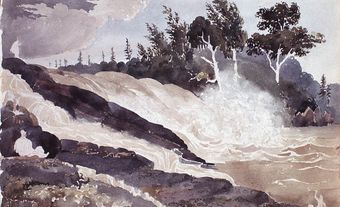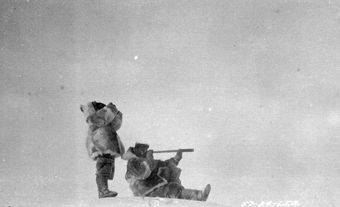
Territory and Population
Baffin Island Inuit live on Baffin Island, the largest island in the Arctic Archipelago and in the territory of Nunavut. As part of the Qikiqtaaluk Region of Nunavut, Baffin Island is home to a number of Inuit communities, including Iqaluit, Pangnirtung, Pond Inlet, Clyde River, Arctic Bay, Kimmirut and Nanisivik. According to the 2016 census, the total Inuit population in the Baffin region was 14,875; the total non-Inuit population was significantly smaller: 5,440.
Early History
Baffin Island has been inhabited by the Inuit for thousands of years. Inuit from Baffin Island are descendants of the Thule, who expanded eastward across Canada from Alaska in the 12th and 13th centuries. The Baffin Island Inuit (like other modern Inuit) share biological and cultural links with their Thule ancestors.
Culture and Society
The Baffin Island Inuit display considerable regional diversity in both language and culture. Those in the far north belong to the Iglulik (Igloolik), who also live on the mainland. The remaining groups, often collectively referred to as the South Baffin Island Inuit, are concentrated along the rugged east coast, including Cumberland Sound and Frobisher Bay, and along the north shore of Hudson Strait. The latter share many cultural traits with the Labrador Inuit on the other side of Hudson Strait, which was frequently crossed for trading purposes.
The use of oral history and traditional knowledge provided by Inuit groups and elders helps to clarify their unique perspectives on pre-European modes of life. (See also Inuit Myth and Legend and The Goddess of the Sea: The Story of Sedna.)
One of the best-known communities just off Baffin Island, on Dorset Island, is Cape Dorset, now recognized around the world for the outstanding soapstone carvings, prints and drawings of its Inuit artists. (See also Inuit Art and Contemporary Inuit Art.)

Language
Inuktitut is a language commonly spoken by many Baffin Island Inuit. The language has several subdialects, including North and South Baffin. According to the 2016 census, 36,015 people of the Indigenous population reported Inuktitut as their mother tongue. (See also Indigenous Languages in Canada.)
Contact with Europeans
Dr. Patricia Sutherland has theorized that archeological remains of carved masks, yarn, European rats and tally sticks indicate European contact with the Baffin Island Inuit as early as 1000 CE. In 2012, Sutherland also announced that the presence of alloys used by the Vikings in whetstones on Baffin Island suggest a possible trade network between the Baffin Island Inuit and the Vikings.
In 1576, the Inuit of Baffin Island made contact with European explorers, when Martin Frobisher traded with the Inuit and, according to different records, kidnapped one or three of them in the bay that now bears his name; more conflict ensued on his 1577 expedition. When Frosbisher returned to Baffin Island in July and August, hostilities with the Inuit were renewed, prompting Frobisher to return to England. He brought with him four Inuit captives, who did not survive more than two months.
Throughout the 18th and early 19th centuries, Inuit along the south coast had occasional trade contacts with European exploration and supply vessels that stopped briefly on their way through to Hudson Bay. Farther north, the Inuit of Davis Strait did not encounter outsiders in any numbers until after 1820, when Scottish and American whalers started making annual visits to Baffin Island through the heavy drift ice of western Baffin Bay.
Inuit material culture was greatly modified by the increased flow of trade goods, including firearms, and by the large supply of wood provided by frequent shipwrecks. Contact with Europeans increased during the late 19th century when whalers started to establish permanent shore stations. Although the Inuit may have welcomed regular trade and occasional employment, it is thought that their population declined rapidly because of dietary changes (see also Country Food in Canada) and exposure to European diseases. As commercial whaling declined in the early 20th century, the Inuit of Baffin Island turned increasingly to fox trapping in order to satisfy their dependence on European manufacturers.
After relocation projects in the 1950s that forcibly removed Inuit from their traditional camps, the Baffin Island Inuit now live in homes in Iqaluit (Frobisher Bay), the transportation hub and largest settlement on the island. (See also Inuit High Arctic Relocations in Canada.)
Environmental Activism
In June 2014, the National Energy Board approved plans from a consortium led by Multi-Klient Invest AS (MKI) to begin five years of seismic testing around Baffin Island. The tests, which use high-intensity sounds, will help map the seafloor and undersea geology. Many Inuit opposed the program, arguing that the testing might harm and disturb local food sources, including seals, whales and walruses.
This movement to stop the testing was not the first instance in which Baffin Island Inuit fought against offshore oil and gas extraction. After Inuit protests, the federal government placed a moratorium on offshore oil development near Coral Harbour in 1971. Seven years later, the Canadian government placed another moratorium on oil development in Lancaster Sound after Inuit groups successfully expressed their opposition to the program. Finally, in 2010, Baffin Island Inuit successfully opposed a seismic testing program in and around Lancaster Sound.
Opposition to seismic testing in Nunavut continues. With support from various organizations, such as the Nunavut Marine Council, Greenpeace, the Qikiqtani Inuit Association, the Sierra Club, Amnesty International, the Inuit continue to defend and protect Arctic lands, waters and wildlife. (See also Indigenous Territory.)
Contemporary Life
As part of the Qikiqtaaluk Region of Nunavut, Baffin Island is home to a number of Inuit communities, including Iqaluit, Pangnirtung, Pond Inlet, Clyde River, Arctic Bay, Kimmirut and Nanisivik. The most eastern administrative region of Nunavut, the Qikiqtaaluk Region is also the most populated.

 Share on Facebook
Share on Facebook Share on X
Share on X Share by Email
Share by Email Share on Google Classroom
Share on Google Classroom





